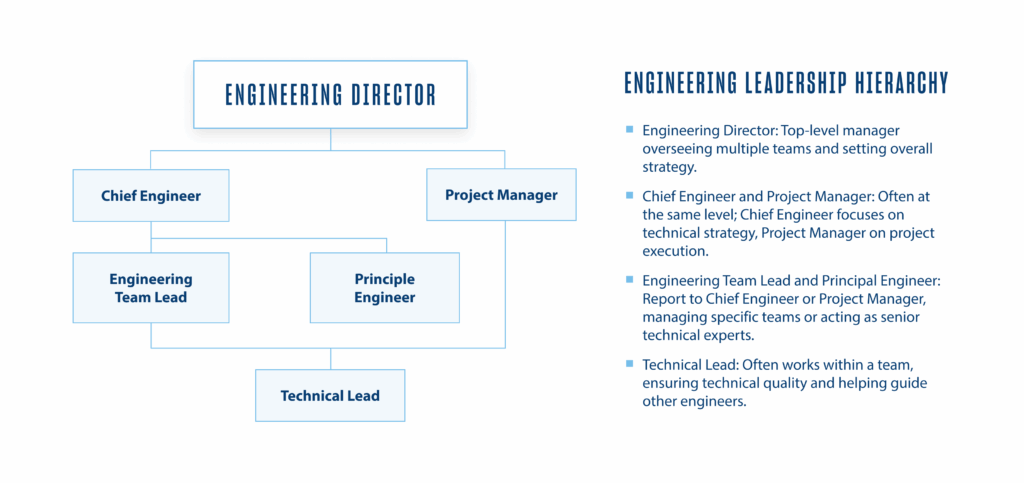It is an exciting moment for engineering leaders, as the next few years look to be pivotal ones for the engineering profession. Engineers are uniquely situated to help address many of our most pressing challenges, from addressing the challenges of climate change and our aging infrastructures to shaping the role of artificial intelligence and digital technology in our daily lives.
But the engineering field faces its own unique challenges that will require skilled and effective leaders. As the rest of the baby boomer generation retires, they’ll take important industry knowledge with them. Replacing these positions with skilled workers will be difficult, especially with the constraints of tight budgets as all industries struggle to shake off the effects of inflation.
Heading into 2025, companies will need passionate and aspiring engineering leaders to step up and address these challenges in a way that’s equitable and sustainable. If you feel that you can be one such leader, this blog post details the engineering leadership skills you should be focusing on.
What Does an Engineering Leader Do?
Engineering leaders are experienced engineers who are capable of combining their technical expertise with strong leadership and management skills to lead teams and projects. The word “experienced” is important, because engineers don’t start as effective leaders. Leadership skills in engineering are developed over time.
Most, if not all, leaders will start as part of an engineering or IT team and will report to a higher-level executive within a company — such as a director of engineering. In this capacity, they will take on increasing responsibility to create the conditions that enable their team to succeed. The specific responsibilities of an engineering leader will vary depending on position, industry and title, but generally consist of the following:
- Managing project resources and budgets: Allocate resources, monitor expenditures and keep projects within budget.
- Planning project schedules and budgets: Develop timelines, mitigate risks and ensure on-time, on-budget delivery.
- Collaborating with team members and stakeholders: Coordinate across functions, share updates and build relationships with contractors.
- Delegating and supervising tasks: Assign work, monitor progress and hold team members accountable for deliverables.
- Hiring and developing employees: Recruit talent, conduct evaluations and provide growth opportunities.
- Promoting teamwork and an inclusive workspace: Cultivate a collaborative team culture with open communication and mutual support to foster productivity and resolve conflicts.
- Creating documentation and roadmaps: Maintain updated project specs and clear roadmaps to guide the team.
- Conducting regular meetings: Hold team meetings and one-on-one check-ins to discuss performance, address concerns and set goals.
- Handling administrative duties: Track performance metrics, prepare reports, conduct reviews and improve processes.
No matter your specific responsibilities, you have to remember that leadership is people-focused. Your goal is to support your team so they can succeed, no matter the scope of a project or the constraints of an environment.
What Jobs Do Engineering Leaders Have?
One of the reasons we refer to leadership instead of management in engineering is that there are many different leadership roles, each with their own tasks and responsibilities. You can have any of the following titles and be an engineering leader:
- Engineering Director: You manage multiple engineering teams or departments, focusing on high-level strategy, resource planning and performance. You support all of your company’s teams by aligning engineering efforts with business objectives and fostering a positive work culture.
- Project Manager: You’re responsible for overseeing project timelines, resources and budgets, ensuring goals are met on time and within scope. You support your team by coordinating tasks, managing risks and facilitating communication with stakeholders.
- Chief Engineer: You lead the technical vision and strategy, ensuring engineering excellence across projects. You support your team by providing high-level oversight, mentoring senior engineers and driving innovation that aligns with larger organizational goals.
- Engineering Team Lead: You manage a specific engineering team’s daily operations and development by setting goals, assigning tasks and offering guidance. You support team growth and work to ensure collaboration and productivity.
- Principal Engineer: You act as a high-level technical expert, solving challenging engineering problems and setting technical direction for projects. You support the team by offering strategic insights and guiding critical technical decisions.
- Technical Lead: You’re focused on the technical aspects of a project, providing deep expertise to others, setting coding standards and troubleshooting complex issues. You support the team by ensuring technical quality and mentoring others on best practices.

Individuals in each of these positions need good management skills and should understand how to lead teams. If you’d like to read more about these foundational elements, our program has written several blog posts on defining leadership in engineering, the essential skills you need to lead and manage others and tips on how to be a more effective engineering manager.
Thinking of moving from a technical career track to becoming an engineering leader? Be prepared for this life-changing decision by downloading and reading our free eBook: From Engineer to Leader.
What Skills Do Today’s Engineering Leaders Need?
All industries have changed greatly over the past few years, to the point where just having the best technical skills isn’t enough to be an effective leader. This means today’s engineering leaders need a balance of technical, business and interpersonal skills.
If you don’t have the ability to adapt to changing circumstances and the skills to work effectively both within your team and with other stakeholders, then you’re going to have a hard road ahead of you. If you want to excel as an engineering leader, then these are the two biggest challenges you’ll be facing and the skills you’ll need to prioritize.
Challenge #1: Working as a global team — Today’s engineering teams are global, especially as many organizations build their teams in countries with lower average salaries. That means, as an engineering leader, you need to work across international lines and collaborate across many different time zones. That means you have to understand how to account for time differences as well as cultural differences and language barriers. If you’re not able to communicate effectively, then you can’t properly motivate or manage your team.
Important skills to build include:
- Project management: Project management isn’t easy, even when the team is located in-person at one location. You have to be able to define specific roles and responsibilities and establish deliverables. The better your project management capabilities, the more you can ensure that projects stay on schedule and within scope and deliver on objectives.
- Emotional intelligence and humility: Building trust and fostering a supportive team environment is critical for high performance. Not being sensitive to our team’s needs or what’s frustrating them leads to misunderstanding and conflict. To be able to adjust to multicultural teams, you’ll need patience and the ability to self-reflect about your own approach.
- Discipline and the ability to lead by example: When it comes to inspiring your teams to maintain high standards and work ethics you have to lead by example, otherwise they won’t buy in. Find ways to rally your team toward a common goal and work directly with them so they’re more comfortable embracing and using new tools and processes.
- Interpersonal communication: You need to be able to understand the needs of the people — what are their bottlenecks? In which areas do they need training? Clear and regular communication is the only way you can set clear expectations and receive feedback, which is essential for reducing misunderstandings and increasing team cohesion.
- Collaboration within and across teams: Effective collaboration requires knowing what cultural differences you need to account for. For example, don’t assume that, because you’re writing specs for the imperial system of measurements, a team that uses the metric system will understand how to make the correct conversions.
- Conflict management and negotiation: Conflicts will inevitably arise, so you’ll need to know how to resolve disputes constructively, preserving team morale and project progress. This can be especially challenging for cross-cultural teams that may approach conflict in completely different ways. This is one area where you’re likely to make a lot of mistakes, but what’s important is that you learn and grow from them.
- Mentorship: As a leader you should always be looking for ways to foster team growth and development. This builds a pipeline of skilled and motivated individuals and creates systems of trust, ensuring that processes can continue even when the unexpected happens.
Challenge #2: Adapting to modern toolsets — Today’s advances in digital technology, from AI to modeling and simulation programs, have introduced many new engineering tools. The greatest potential benefit of these tools is to reduce product development time, which enables your teams to bring products to market at a much faster rate. However, effective use of these tools requires training and experience to use well.
- Adaptable technical skills: The adoption of new technologies is faster than ever, to the point where team leads are expected to integrate innovations within months — not years. You’ll need to continually revise your technical skills as new technologies are introduced, to ensure you can guide your teams through technological changes and updates.
- Be flexible in your processes: Industry disruptions are a fact of life for everyone, now more than ever. So while you can’t see the future, you do need the ability to quickly adjust to changes in the market. If your timeline for product development gets cut in half, how are you going to lead your team to a viable solution?
- An understanding of business and financial matters: No effective engineering leader operates in a bubble. You have to understand how to align the company’s technical efforts with larger business goals and budget constraints. This not only helps your own operations, but can win trust and influence with other teams and departments.
- Creative problem solving: You need to be creative and innovative about how you approach problems. Engineers can default to thinking about how to create a new solution, when in practice the more elegant answer may be to platform an existing solution in an innovative way to create exciting new synergies or brand new processes.
- Systems thinking: Make use of systems thinking tools to inform a more holistic perspective of your teams. There are systems mapping tools that can help you to define the roles of each team and what their responsibilities are, as well as how they interconnect, relate and act so you can identify interdependencies and optimize the whole system.
- Strategic delegation and facilitation: You can’t take on everything yourself. Delegating responsibilities is key to being a leader, but providing your team with the tools and training to support them is what can make you a great leader. Project organization tools can help you refine the workload distribution and empower your team members to take ownership of their work.
Don’t feel that you have to be an expert in everything before you can find success. The number of skills you learn isn’t what matters, but rather that you are a life-long learner.Curiosity and a love for learning is what will best prepare you for evolving industry trends, allowing you to be flexible enough to adjust to any particular challenge and arrive at the right solution.
Thinking of moving from a technical career track to becoming an engineering leader? Be prepared for this life-changing decision by downloading and reading our free eBook: From Engineer to Leader.
How to Improve Engineering Leadership Skills
The advice here is to always be open to learning. You can develop your skills and knowledge in any number of ways, but as long as you push yourself to keep learning, you’ll continue to develop the leadership skills you need.
As for which areas of learning can be the most effective, consider the following recommendations:
- Supplement your technical knowledge with experience on the business side, such as cost-benefit analysis and an understanding of product markets. Having this additional perspective is essential for your career advancement, whether it’s gained through on-the-job experience or practical co-op experience by earning a degree in business administration.
- Always look for opportunities to lead projects and teams. You’ll come to understand that effective leadership isn’t micromanagement, but knowing when to delegate responsibilities and trust that your engineers can get things done. The more you put yourself in a leadership role, the more you’ll understand how to prioritize tasks, knowing when to focus on certain areas and when to abandon others.
- Find great mentors. Mentorship is one of the most effective ways that you can gain important, institutional knowledge. There are many things that you won’t learn in an academic program and there are some insights that will take you years to develop by yourself. Mentors are an essential resource for effective career advice.
- Earn an advanced degree. Pursuing specialized graduate degree programs in engineering management (MEM), technology management (MSTM) or the Master’s in Engineering Management and Leadership (EML) is a great way to build knowledge, develop your network and gain access to valuable resources. Online programs are especially helpful for developing your skills while working at a full- or part-time position.
- Always strive to be agile, open minded and willing to change. Today’s engineering landscape is constantly changing, so you need to keep pace with it. When you look back on your career, ten years from now or even five years from now, you should not be the same leader you are now. You can’t predict the future, but you can prepare for it by reflecting on where you’ve been, accounting for where you are and looking ahead to where you want to be.




